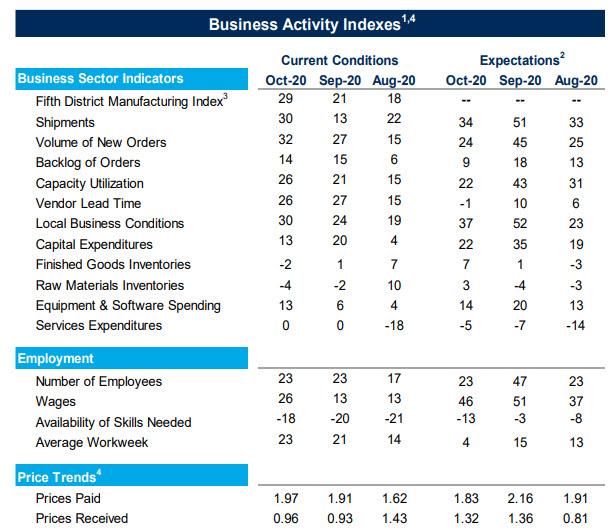Richmond Fed Smashes Expectations, Hits Record High
Tyler Durden
Tue, 10/27/2020 – 10:13
The K-shaped recovery continues, and even as some states seeing a sharp pullback in economic conditions, others are thriving. The mid-Atlantic states that comprise the Richmond Fed district are among the latter, and in fact according to the latest Richmond Fed manufacturing index, conditions have never been better with the index hitting the highest in its post-1993 record.
After sliding to a record low -54 in March, the index jumped to 21 in September, just shy of the all time high. The momentum then continued in October, when the mfg. survey hit a record 29, smashing both consensus expectations of 18 and the highest estimate among the 10 economist surveyed which was 19.
The record print was “buoyed by increases in the shipments and new orders indexes, while the third component—the employment index—was unchanged. Firms reported improving business conditions and growing backlogs of orders, overall. Manufacturers were optimistic that conditions would continue to improve in the coming months”
Some details:
- Volume of New Orders jumped to 32 from 27 in August
- Shipments exploded to 30 after 13 in August
- Equipment and software spending doubled from 6 to 13
There were two areas of concern: capex declined from 20 to 13, while number of employees was flat at 23:
Looking at employment, the survey results indicated that many manufacturers continued to increase employment and wages in October. However, firms struggled to find workers with the necessary skills. Contacts expected these trends to continue in the next six months.
Finally, in perhaps the best sign of a recovery, the survey find nascent inflationary signs, with average growth rates of both prices paid and prices received by survey participants increased slightly in October. Growth of prices paid continued to outpace that of prices received, but contacts expected the gap to narrow in the near future.
That said, now that the mid-Atlantic region is getting hit by a second (and in some cases third) wave of infections, it’s all downhill from the record print.

